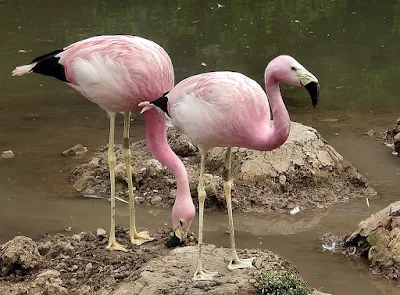20 Interesting Facts About Flamingos
- A flamingo is a tall wading bird. These birds are present in parts of Africa, Asia, Europe, and the Americas.
- Flamingos fly at an average speed of 60 km/h and can cover a distance of 375 miles in a single night. This bird can attain a height of 15,000 feet during its flight. Before their flight, they take a short runway by flapping their feathers and running on water.
- Flamingos eat with heads upside down. Unlike other birds, flamingos have a much larger lower bill while their upper bill does not attach. It helps the bird to eat with an upside-down head. Their Mouth keeps the food in and water out. (Source)
- Flamingos are one of the few birds that produce “bird milk,” also known as crop milk. Both male and female feed their chicks with crop milk for two months. It has a higher fat and lower protein content than pigeon’s milk and is also rich in red and white blood cells. (Source)
- The world’s oldest flamingo died at the age of 83 years in 2014 at Adelaide Zoo. It was also the last greater flamingo that resided in Australia. (Source)
- Flamingos are social birds that live in colonies of varying sizes. These colonies have a minimum of around 50 members and can be as large as 1 million flamingos. They come together in lagoons and mudflats.
- There are 6 species of flamingos. These include Greater flamingo, Lesser flamingo, American (or the Caribbean) flamingo, Andean flamingo, Chilean flamingo, and Puna (or James) flamingo. The greater flamingo is the tallest, while the lesser flamingo is the smallest of all the species.
- Lesser flamingos have the highest population among all species of flamingos. The total population of these African flamingos is between 1.5 and 2.5 million.
- The greater flamingo is the most widely distributed species of flamingos, present in the Middle East, India, Africa, and the Mediterranean. It also has the second-highest population among these birds.
- Flamingoes can filter mud and other unwanted substances through their bills while eating food. The filter in lesser flamingos is finer than that of greater flamingos. It allows both species to consume food in the same lake without competition. (Source)
- There are 12 flight feathers under their wings. These black feathers are visible during their flight.
- The flamingo is the national bird of the Bahamas. This bird also represents the national symbol of the country.
- The
most prominent feature of flamingos is their bright pink color. The meaning of
flamingo in Spanish or Portuguese is “flame-colored.” This pink color of their
feathers is the result of their diet. The algae, larvae, and brine shrimp that
flamingos eat are rich in beta-carotene. Their color at birth is dull grey. (Source)

Pink color is the most common feature in flamingos - Another unique feature of flamingos is standing on one leg during rest. Possible reasons behind this trait are to reduce muscle fatigue or to maintain body temperature. (Source)
- The closest relatives of flamingos are grebes. Both these birds have similar DNA and morphological traits despite their different appearance. They have matching muscles, forelimbs, spines, feathers, vertebrae, nests, etc.
- Flamingos are vulnerable during their flight and while staying on land. Vultures, storks, big cats, jackals, hyenas, and pythons are common predators of flamingos.
- The flamingo’s tongue was considered a delicacy in Ancient Rome, thanks to its “especially fine flavor.”
- There is a misconception that the egg yolks of flamingoes are pink in color. But in reality, the color of a flamingo’s egg yolk can vary from “bright orange” to “reddish.” (Source)
- Flamingos usually lay one egg per year. Both males and females take part in the incubation of eggs. (Source)
- Flamingos are one of the few animals with homosexual behavior. Two male flamingos have raised three chicks in six years after stealing them from other flamingos. (Source)



Comments
Post a Comment